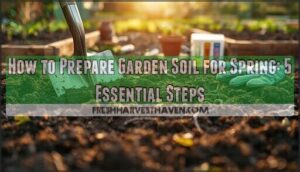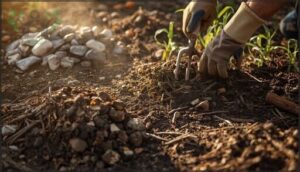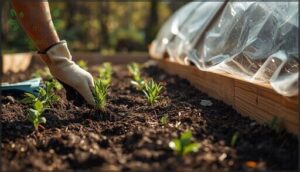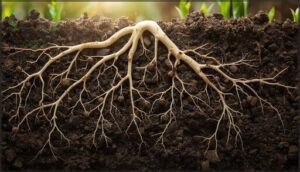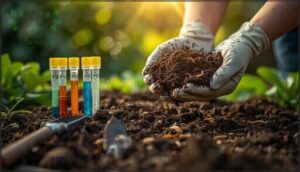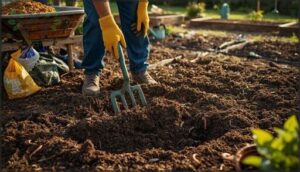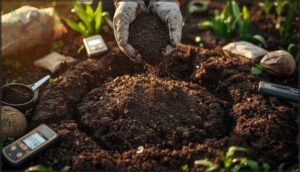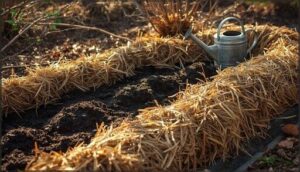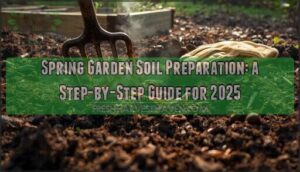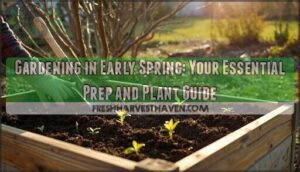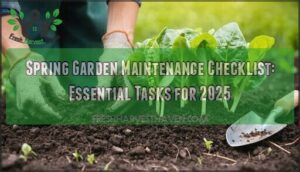This site is supported by our readers. We may earn a commission, at no cost to you, if you purchase through links.
Your spring harvest success gets decided long before the first seed hits the ground. Healthy garden soil teeming with beneficial microbes and balanced nutrients can boost vegetable yields by 30 to 50 percent compared to depleted, compacted earth. But most gardeners skip the groundwork—literally—and wonder why their tomatoes struggle or their carrots fork into twisted shapes.
The secret lies in what you do now, while the ground is still workable and before planting fever takes over. From clearing debris and testing pH levels to loosening compacted layers and feeding soil biology, a few targeted steps transform tired dirt into a thriving foundation that fosters vigorous root systems and abundant growth all season long.
Table Of Contents
- Key Takeaways
- Clear Debris and Prepare The Garden Bed
- Test and Assess Your Garden Soil
- Improve Soil Structure and Fertility
- Amend and Balance Soil for Spring Planting
- Maintain Soil Health Leading Up to Planting
- Frequently Asked Questions (FAQs)
- When should I start prepping my garden for spring?
- How do you prepare a garden bed for spring?
- What is best to put on soil before planting?
- How to amend garden soil in the spring?
- How deep should I dig my garden beds?
- Can I prepare soil with clay?
- When is the best soil preparation time?
- What tools do I need for soil?
- How often should I test garden soil?
- How often should garden soil be replaced?
- Conclusion
Key Takeaways
- Spring garden success starts with soil prep 4-6 weeks before your last frost date, when temperatures hit 50°F and the ground crumbles easily—this timing lets you clear debris, test pH, and build structure before planting fever takes over.
- Healthy garden soil boosted with 2-4 inches of compost or aged manure can increase vegetable yields by 30-50% compared to neglected ground, because organic matter feeds beneficial microbes that unlock nutrients your plants can actually use.
- Your soil test results give you a clear roadmap for targeted fixes—whether that’s lime to raise pH, sulfur to lower it, or specific NPK ratios to balance nitrogen, phosphorus, and potassium—so you’re not guessing or wasting money on amendments your garden doesn’t need.
- Loosening soil to 8-12 inches deep and adding a 2-4 inch mulch layer creates the ideal foundation for root growth while cutting moisture loss by up to 70% and blocking weeds before they start.
Clear Debris and Prepare The Garden Bed
Before you plant a single seed, you need a clean slate. A garden bed cluttered with debris creates problems—blocking water flow, harboring pests, and stealing nutrients from your plants.
Here’s how to clear your space the right way and set yourself up for a thriving spring garden.
Remove Rocks, Branches, and Plant Debris
A clean garden bed is the foundation of spring success. Start by removing rocks larger than 2 cm from the top 6 inches—they block roots and make digging frustrating. Clear branches, twigs, and plant debris to reduce pest hideouts and disease carryover.
Your debris removal checklist:
- Rake leaf litter to borders to prevent mold buildup
- Lift large rocks with a garden fork to avoid back strain
- Wear gloves to protect against sharp stones and splinters
- Compost healthy plant residues or follow local yard waste guidelines
This simple garden cleanup improves soil aeration and weed prevention while setting the stage for healthy soil preparation techniques.
Eliminate Weeds and Weed Seeds
After debris removal, tackle weeds before they spread. Hand pull young seedlings to cut seed production by up to 90 percent—timing beats strength here.
For stubborn patches, try soil solarization: lay clear plastic over moist beds for four to six weeks when temps hit 130°F. You’ll kill surface seeds and gain weed prevention that lasts.
Follow with a two-inch mulch layer for ongoing weed control and improved garden soil preparation.
Leave Beneficial Plant Roots in Soil
While you’re clearing weeds, leave most plant roots right where they are. Those root channels boost soil porosity and feed beneficial microbes that speed up nutrient cycling come spring.
Decomposing root residue adds organic matter and improves microbial activity without extra work. You’ll strengthen soil health and support soil conservation—just remove any diseased roots to protect next season’s crops.
Test and Assess Your Garden Soil
You can’t build a healthy garden on guesswork. Before you add a single shovelful of compost or sprinkle any amendments, you need to know what you’re working with.
Before you amend anything, test your soil—healthy gardens are built on data, not guesswork
Testing your soil now gives you a clear roadmap for the improvements your garden actually needs.
Determine Soil Texture (Clay, Sand, Silt, Loam)
Your garden soil texture sets the stage for everything—roots, water, nutrients. Start with the feel test: rub moist soil between your fingers. Clay feels sticky and smooth. Sand is gritty and won’t hold shape. Silt feels silky and flour-like. Loam strikes that ideal balance—crumbly yet moldable.
For deeper soil texture analysis, try these quick field tests:
- Ribbon test: Roll damp soil into a ribbon between your thumb and fingers; longer ribbons mean higher clay content and fine particle size.
- Jar test: Shake garden soil with water in a clear jar, then let it settle into visible layers showing sand at bottom, silt middle, clay top—simple soil classification.
- Ball test: Squeeze moistened soil into a ball; if it crumbles easily, you’ve got sandy soil; if it holds firm, clay dominates your soil preparation needs.
- Professional soil test: Labs analyze exact percentages for precise texture mapping and soil pH insights beyond what home methods reveal.
Understanding your soil texture guides every amendment choice ahead.
Test Soil PH and Nutrient Levels
A calibrated digital meter or home kit reveals your soil pH—the sweet spot for most vegetables falls between 6.0 and 7.0. Pair that with a soil test measuring nitrogen, phosphorus, potassium, and micronutrients like iron or zinc.
Soil sampling from multiple spots across your bed gives accurate nutrient analysis. These results guide precise fertilizer application, ensuring healthy microbial balance and strong nutrient retention before you plant.
Identify Drainage and Compaction Issues
After heavy rain, watch for puddles that linger—it’s your first clue to drainage patterns and soil compaction lurking beneath. Poor water infiltration signals trouble for root growth, so tackle these issues head-on:
- Run a simple rain test to check how quickly water soaks in; slow drainage means compaction testing is next.
- Push a garden fork 8 inches down—if it’s a struggle, soil density is too high.
- Look for standing water or crusted surfaces indicating poor soil aeration and restricted movement.
Proper soil preparation resolves these barriers before spring planting begins.
Improve Soil Structure and Fertility
Once you know what your soil needs, it’s time to roll up your sleeves and get to work. The steps you take now will transform tired, compacted ground into a thriving foundation for your spring garden.
Let’s walk through the three key actions that’ll give your plants the best possible start.
Loosen Soil to Proper Depth
Think of your soil as a living ecosystem that needs room to breathe. You’ll want to loosen it to 8 to 12 inches deep—that sweet spot for root depth and soil aeration without disrupting soil structure.
Use tillage methods that match your soil texture, and watch your depth control carefully.
Work when moisture levels are just right to prevent soil compaction, and you’ll set the stage for vigorous spring growth.
Add Organic Matter (Compost, Aged Manure)
Organic matter is what transforms basic dirt into a thriving foundation for your plants. Apply a 2 to 4-inch layer of finished compost or aged manure, then blend it into the loosened soil to jumpstart nutrient cycling and build a home for beneficial soil microbes.
- Compost benefits: Boosts water-holding capacity by 20 to 30 percent while improving drainage
- Manure application: Choose aged sources to avoid burning tender roots with excess nitrogen
- Soil health: Creates habitat for microbes that release nutrients your plants can actually use
Incorporate Worm Castings and Organic Fertilizers
Worm casting benefits go beyond basic organic fertilizer—they boost nutrient cycling by feeding soil microbes that transform organic matter into plant-available food.
Mix 5 to 20 liters per 100 square meters into your compost blending routine, working them into the top 6 to 8 inches during soil preparation.
Pair with all-purpose organic fertilizers for a balanced approach that respects your soil pH.
Amend and Balance Soil for Spring Planting
Your soil test results give you a clear roadmap for what your garden needs. Now it’s time to adjust pH levels and add the right nutrients so your plants can actually use what’s in the soil.
Here’s how to make those targeted amendments that set your garden up for success.
Adjust Soil PH With Lime or Sulfur
Your soil test reveals whether you need lime to raise pH or sulfur to lower it.
For acidic soil remedies, spread lime at rates recommended by extension guidelines—usually raising pH by 0.5 to 1.0 units per application. To lower pH, apply elemental sulfur carefully.
Work amendments into the top 6 to 8 inches during soil preparation, then retest in 6 to 12 weeks to confirm your soil pH balance is on track.
Blend in Nutrients (NPK Balance)
After correcting pH, it’s time to address NPK ratios—nitrogen, phosphorus, and potassium. Your soil test shows exactly what’s lacking.
Add nitrogen for leafy growth, phosphorus for strong roots, and potassium for overall vigor. Choose fertilizer types that match your needs: slow-release granular formulas or compost-based soil amendments.
Don’t forget micronutrients like zinc and iron—they support nutrient cycling and keep plants thriving.
Choose Amendments Based on Soil Test Results
Your soil test reveals the gaps—now you can pick amendments that fix them, not guess. Here’s how to match your inputs to the results:
- Use elemental sulfur to lower pH in neutral-to-alkaline soils when needed
- Apply calcium supplements like calcium carbonate to raise pH in acidic soils
- Add compost or aged manure to improve nutrient holding capacity
- Skip extra phosphorus or potassium if levels already run high
- Target fertilizers to balance nutrient deficiency ratios shown in your analysis
When evaluating the effectiveness of these methods, consider the importance of methodological rigor in scientific studies.
Maintain Soil Health Leading Up to Planting
You’ve done the heavy lifting—now it’s about protecting what you’ve built. The weeks leading up to planting are your window to lock in moisture, feed the soil naturally, and catch any issues before they matter.
Here’s how to keep your garden bed in peak condition until it’s time to plant.
Apply Mulch to Retain Moisture and Suppress Weeds
A well-chosen mulch layer works like an all-season guardian for your soil. Spread wood chips, shredded bark, or compost 2 to 4 inches deep across your beds to cut moisture loss by up to 70% while blocking light that triggers weed germination.
Keep mulch a few inches away from plant crowns to prevent rot, and you’ll enjoy healthier soil temperature and less watering through spring.
Use Cover Crops or Green Manures
Beyond mulch, planting cover crops or green manure through winter gives your soil a living boost. Legumes like crimson clover fix nitrogen—adding up to 200 kg per hectare—while cereal rye suppresses weeds and prevents erosion.
Terminate them at flowering, then incorporate the biomass to feed microbes and improve structure. It’s crop rotation that pays dividends before you even plant.
Monitor Soil and Make Final Adjustments Before Spring
As winter transitions, check your soil nitrogen weekly—nitrate-N can shift 20% after heavy rain, affecting spring readiness. Test pH and compaction one last time, adjusting with lime or sulfur based on current readings.
Monitor moisture biweekly to support microbial balance. Use updated soil testing results to fine-tune fertilizers, ensuring your soil preparation fosters vigorous soil health without nutrient burn when planting begins.
Frequently Asked Questions (FAQs)
When should I start prepping my garden for spring?
Start your garden preparation about four to six weeks before your area’s last expected frost date. Check local weather forecasts and monitor soil temperature—once it consistently reaches 50°F, you’re ready to begin spring planting.
How do you prepare a garden bed for spring?
Preparing a garden bed means clearing debris and testing soil texture and pH, loosening compacted zones, incorporating compost and amendments, adjusting nutrient balance.
Then, mulching is used to suppress weeds and retain moisture before spring planting.
What is best to put on soil before planting?
The “perfect soil” aisle can feel like a snake-oil convention. You’ll want well-aged compost, organic fertilizers, microbial boosters, pH balancers, and nutrient enhancers—but soil preparation means choosing amendments your soil test actually demands, not every bottle promising miracles.
How to amend garden soil in the spring?
Blend organic matter like compost and aged manure into the top 6–12 inches. Adjust pH with lime or sulfur based on test results.
Add spring fertilizers to boost soil microbes and support garden ecology.
How deep should I dig my garden beds?
Think of your garden bed as a layered cake—roots need room to spread. Dig 8 to 12 inches deep for most vegetables.
Root crops like carrots demand the full foot for proper growth and nutrient access.
Can I prepare soil with clay?
Yes, you can transform clay soil into a productive garden bed. Add compost or aged manure regularly to boost microbial activity and improve drainage. Mulching prevents crusting while maintaining the soil structure you’ve worked to build.
When is the best soil preparation time?
Timing is everything, they say—and your garden agrees.
Start soil preparation two to four weeks before your last expected frost date, when soil temperatures reach 50°F and the ground crumbles easily without clumping.
What tools do I need for soil?
You’ll need a sturdy spade for digging, garden rakes for leveling, a soil test kit, and a broadfork for soil aeration.
Don’t forget compost turners, wheelbarrows for mulch and fertilizer transport, plus tool sharpening equipment.
How often should I test garden soil?
Like checking your car’s oil, soil testing keeps your garden running smoothly. Test established beds every 2-3 years, but check new gardens annually to track nutrient deficiencies and soil pH levels as you build soil health.
How often should garden soil be replaced?
Garden soil rarely needs full replacement—most gardeners never do it. Focus on soil testing and remediation steps first. Only replace when contamination risks or severe damage make improvement impossible.
Conclusion
Yes, preparing garden soil for spring takes effort—but it’s effort that pays dividends from first sprout to final harvest. Each step you take now—clearing debris, testing pH, loosening compacted layers, adding compost—builds a foundation that feeds your plants all season long.
Think of it as setting the table before guests arrive: the meal tastes better when everything’s ready. Your garden will thank you with stronger roots, healthier plants, and yields that make every shovelful worthwhile.
- https://rocklandcce.org/resources/composting-made-easy
- https://extension.usu.edu/yardandgarden/research/gardening-in-clay-soils
- https://www.nrcs.usda.gov/sites/default/files/2022-11/pH%20-%20Soil%20Health%20Guide_0.pdf
- https://www.nsf.gov/news/black-eyed-peas-could-help-eliminate-need
- https://fathernaturelandscapes.com/location/birmingham-alabama/

